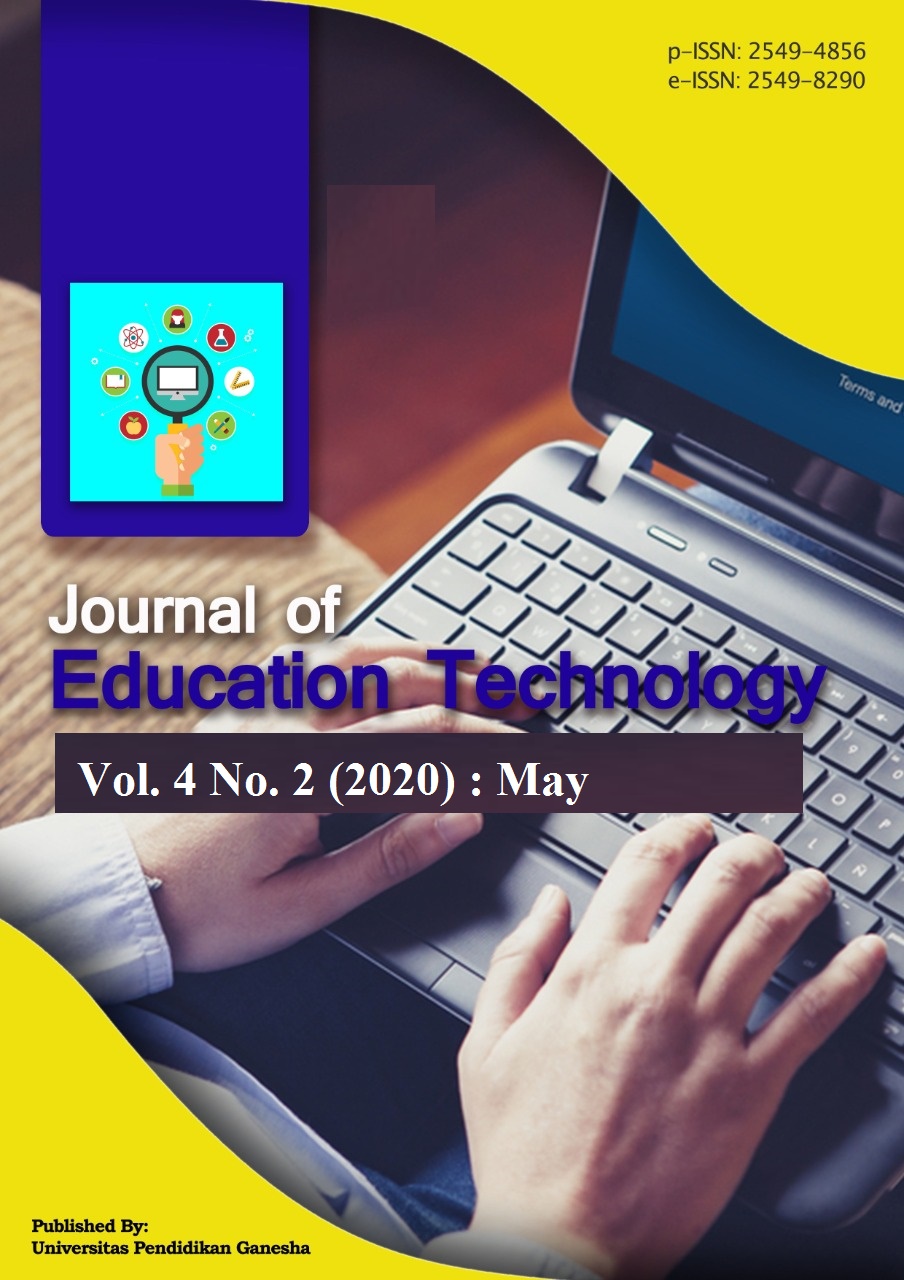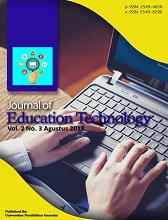Mobile Assisted Language Learning in Intensive English Course for Freshmen Year Students
DOI:
https://doi.org/10.23887/jet.v4i2.25097Keywords:
IEC, MALL, first semester studentsAbstract
Learning on twenty first century has influenced the use of technology especially as contextual learning media in the classroom. Moreover, digital generation students have already known the role of technology and have adapted it successfully. Therefore, it was very important to introduce attractive and active learning by using authentic activities and one of these activities was called Mobile Assisted Language Learning (MALL). This learning brought the world’s information only to the students’ smart phone. In contrast to traditional learning in the classroom, the students did not fully gain knowledge in the classroom. In fact, the implementation of MALL could give students’ freedom to learn in terms of time and place. The result of this research showed that students had obstacles in learning especially in terms of activities and the used of teaching media. Students needed authentic learning media that could improve their four skills.References
Bezircilioğlu, S. (2016). Mobile assisted language learning. Journal Of Educational And Instructional Studies In The World, 6(1), 9–12.
Bonces, J. R. (2012). Content and Language Integrated Learning (CLIL): Considerations in the Colombian Context. Gist Education and Learning Research Journal, 6(6), 177–189.
Csobanka, Z. E. (2016). 2 Generations Research : X , Y , Z. Acta Technologica Dubnicae, 6(2), 63–76. https://doi.org/10.1515/atd-2016-0012
Darmuki, A., Andayani, M., Nurkamto, J., & Saddhono, K. (2016). International Journal of Languages ’ Education and Teaching Education Study Language And Literature Indonesia. International Journal of Languages’ Education and Teaching, (2), 1–14. https://doi.org/10.18298/ijlet.611
Fatimah, A. S. (2017). Teaching In 21 st Century : Students- Teachers ’ Perceptions Of Technology Use In The Classroom. Journal of Linguistic and English Teaching, 2(2).
Hashim, H. (2018). Application of technology in the digital era education. International Journal of Research in Counseling and Education, 01(02), 1–5. https://doi.org/10.24036/002za0002
Klopfer, E.; K. Squire, and H. Jenkins. (2002). "Environmental Detectives: PDAs as a window into a virtual simulated world." In: Proceedings of IEEE International Workshop on Wireless and Mobile Technologies in Education. Vaxjo, Sweden: IEEE Computer Society, pp. 95-98
Kopáčková, H. (2016). Characteristics of digital natives generation in the context of mobile learning, (July 2015). https://doi.org/10.1109/DT.2015.7222966
Ligi, B. & W. D. R. (2017). Mobile learning in higher education. International Journal of Research - Granthaalayah, 5, 2–7.
Lorena, C., & Sadiku, M. (2015). The Importance of Four Skills Reading , Speaking , Writing , Listening in a Lesson Hour. European Journal of Language and Literature Studies, 1(1), 29–31.
Madhumathi, G. R. & P. (2017). Review on Use of Mobile Apps for Language Learning. International Journal of Applied Engineering Research, 12(21), 11242–11251.
Mandala Putra, M. A., & Santosa, Made Hery, Susanti, K. R. (2018). Investigation of the Effect of Orai Smartphone-Based Application on Speaking Competency for Adult Learners. Conference Proceedings-The Fourth International Conference On English Across Cultures, (October).
Miangah, T. M., & Nezarat, A. (2012). Mobile-Assisted Language Learning. International Journal of Distributed and Parallel System (IJDPS), 3(1), 309–319.
Phuapan, Piatip, Viriyavejakul, chantana, & Pimdee, P. (2015). Elements of Digital Literacy Skill. International Conference on Developing Real-Life Learning Experience: Lifelong Learning Skills in The 21st Century EL, (June). Retrieved from www.inded.kmitl.ac.th/DRLE2015 Faculty
Sarrab, M., & Elgamel, L. (2012). M Obile L Earning ( M-L Earning ) and, (July), 31–38.
Sato, T., Murase, F., & Burden, T. (n.d.). Is mobile-assisted language learning really useful ? An examination of recall automatization and learner autonomy, (2015), 495–501.
Sugiyono. (2010). Metode Penelitian Kuantitatif Kualitatif dan R&D. Bandung: Alfabeta.
Ulum, Ö. G. (2016). A Needs Analysis Study For Preparatory Class Elt Students. European Journal of English Language Teaching, 1(January 2015). https://doi.org/10.5281/zenodo.51774
Zhang, H., & Burston, J. (2011). Reexamining The Effectiveness of Vocabulary Learning Via Mobile. Tojet: The Turkish Online Journal of Educational Technology, 10(3), 203–214.
Downloads
Published
How to Cite
Issue
Section
License
Authors who publish with the Journal of Education Technology agree to the following terms:
- Authors retain copyright and grant the journal the right of first publication with the work simultaneously licensed under a Creative Commons Attribution License (CC BY-SA 4.0) that allows others to share the work with an acknowledgment of the work's authorship and initial publication in this journal.
- Authors are able to enter into separate, additional contractual arrangements for the non-exclusive distribution of the journal's published version of the work (e.g., post it to an institutional repository or publish it in a book), with an acknowledgment of its initial publication in this journal.
- Authors are permitted and encouraged to post their work online (e.g., in institutional repositories or on their website) prior to and during the submission process, as it can lead to productive exchanges, as well as earlier and greater citation of published work. (See The Effect of Open Access)


















